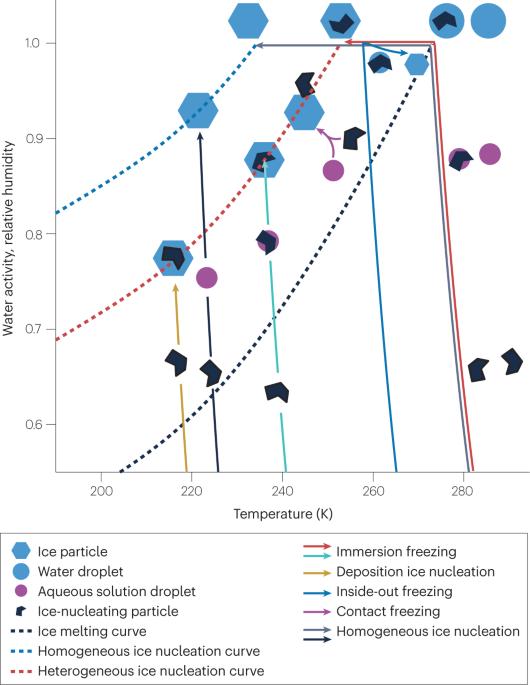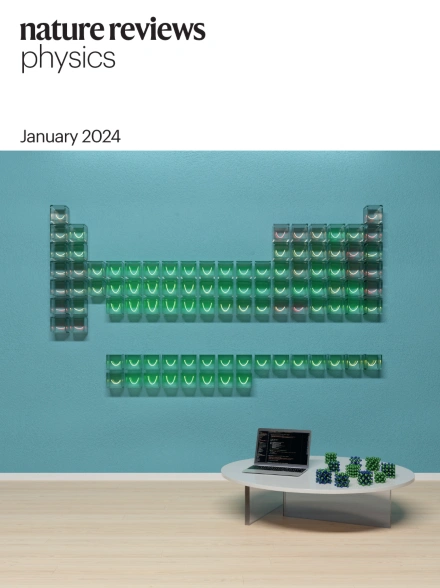大气成冰
IF 39.5
1区 物理与天体物理
Q1 PHYSICS, APPLIED
引用次数: 17
摘要
大气冰核化对全球降水至关重要,并影响云的结构、寿命和反射率,从而对气候产生影响。在广泛的温度和湿度范围内,冰以各种方式从气溶胶粒子(称为冰核粒子)中成核。要将基础物理学与基于理论的冰形成预测联系起来,以便在云和气候模型中实施,就必须量化成核的动力学和热力学机制。我们回顾了近年来冰核形成的分子图景是如何发展的,以及对冰核形成的解释和参数化产生的影响。这些进展包括界面自由能和压力对冰成核率的作用、产生临界冰核的水的流动性区域、成核的经典和非经典途径、形成的冰的多晶体类型、溶质对冻结的影响以及纳米孔作为促进冰成核的表面特征的作用。我们还介绍了目前在模型环境中应用的经过讨论和评估的冻结参数。最后,我们概述了我们认为目前需要改进对冰成核的预测理解。为云层和气候建模预测气溶胶粒子在大气中形成的冰仍然具有挑战性。本综述总结了最近在应用实验和计算理论研究导致液滴和固体基质形成冰核的控制参数方面取得的基本进展。本文章由计算机程序翻译,如有差异,请以英文原文为准。

Atmospheric ice nucleation
Atmospheric ice nucleation is crucial for global precipitation and affects the structure, lifetime and reflectivity of clouds, thereby impacting climate. Ice nucleates in various ways from aerosol particles, termed ice-nucleating particles, over an extensive temperature and humidity range. Quantifying the kinetic and thermodynamic regimes of nucleation is necessary to relate fundamental physics to theoretically based predictions of ice formation for implementation in cloud and climate models. We review how the molecular picture of ice nucleation has advanced in recent years and consequential impacts on the interpretation and parameterization of ice nucleation. Advances include the role of interfacial free energy and pressure on ice nucleation rates, mobility regions of water that generate the critical ice nucleus, classical and non-classical pathways of nucleation, the type of ice polymorph that forms, the impact of solutes on freezing and the role of nanopores as surface features promoting ice nucleation. We also introduce currently debated and evaluated freezing parameterizations for application in model environments. Finally, we outline what we believe are the current needs for improving predictive understanding of ice nucleation. Predicting atmospheric ice formation from aerosol particles for cloud and climate modelling remains challenging. This Review summarizes recent fundamental advances on the governing parameters that lead to ice nucleation from liquid droplets and solid substrates, applying experiments and computational theory.
求助全文
通过发布文献求助,成功后即可免费获取论文全文。
去求助
来源期刊

Nature Reviews Physics
Multiple-
CiteScore
47.80
自引率
0.50%
发文量
122
期刊介绍:
Nature Reviews Physics is an online-only reviews journal, part of the Nature Reviews portfolio of journals. It publishes high-quality technical reference, review, and commentary articles in all areas of fundamental and applied physics. The journal offers a range of content types, including Reviews, Perspectives, Roadmaps, Technical Reviews, Expert Recommendations, Comments, Editorials, Research Highlights, Features, and News & Views, which cover significant advances in the field and topical issues. Nature Reviews Physics is published monthly from January 2019 and does not have external, academic editors. Instead, all editorial decisions are made by a dedicated team of full-time professional editors.
 求助内容:
求助内容: 应助结果提醒方式:
应助结果提醒方式:


